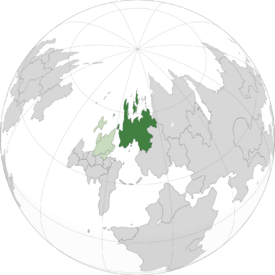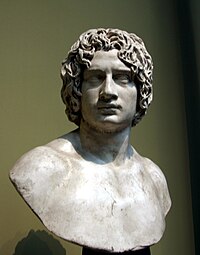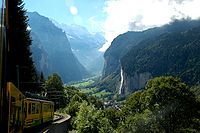Tyrnica: Difference between revisions
mNo edit summary |
(→Language: Added information pertaining to language in Tyrnica) |
||
| Line 216: | Line 216: | ||
===Language=== | ===Language=== | ||
The {{wp|Tyrnican language}} is sole the official language of Tyrnica, and is also its most commonly-spoken language. Tyrnican is a {{wp|West_Germanic languages|Western Isaric}} language, closely related to {{wp|English_language|Rythenean}}. It is more distantly related to the {{wp|North_Germanic languages|Northern Isaric languages}} including {{wp|Danish_language|Kürskäringan}}, which constitues a regional language in [[Administrative divisions of Tyrnica|Kürskäringar]] and [[Administrative divisions of Tyrnica|Mijörlicht]]. Additionally, the {{wp|Czech language|regional language}} of [[Administrative divisions of Tyrnica|Evzenia]] also has administrative status within the boundaries defined by the Tyrnican Academy of Language. | |||
It is estimated that 86.0% of Tyrnican permanent residents speak the language natively, with the remainder usually speaking a regional language. A 2018 survey conducted by the Academy of Language showed that 68.9% of Tyrnicans indicated a proficiency in two or more languages, with the most common {{wp|second languages}} including Rythenean, Kürskäringan and several {{wp|langues d'oïl|Vervillian languages}}. {{wp|Standard German|Standard Tyrnican}} is based on a dialect of {{wp|High German|High Tyrnican}} and is common along the nation's ''Völkgürtel'', while {{wp|Low German|Low Tyrnican}} is typically spoken along the coastline of [[Administrative divisions of Tyrnica|Umbrecht]] and in Grênstedt. | |||
Historically, Tyrnican served as a {{wp|lingua franca}} and was particularly seen in this capacity during the 19th and early 20th centuries; significant Tyrnican-speaking communities remain in [[Blayk|Sarbéliard]] ({{wp|Luxembourgish|Särpelgard Tyrnican}}) and [[Avilême-sur-Mer]] as a result of its widespread usage. Its continued relevance on the global scale has resulted in its adoption as one of the three official languages of the Auressian Community. | |||
===Religion=== | ===Religion=== | ||
Revision as of 08:53, 8 February 2020
Grand Kingdom of Tyrnica Väldig-Königreich Týrland (Tyrnican) | |
|---|---|
| Motto: "Wegen der kälde erlangen stärke" "Through the cold comes strength" | |
| Anthem: März des Nordens "March of the North" | |
 Location of Tyrnica | |
| Capital | Essarien-Königspfalz |
| Largest city | Stierstandt |
| Official languages | Tyrnican |
| Recognised regional languages | Kürskarish, Evzenian |
| Demonym(s) | Tyrnican |
| Government | Unitary parliamentary constitutional monarchy |
• Monarch | Frederick IV |
| Kristen Lehmann | |
| Legislature | Rechtzuhör |
| Haus des Königsrath | |
| Haus der Volksvertreter | |
| Establishment | |
• Coronation of Audun I | 1 November 463 |
• Union with Kürskäringar | 7 September 1479 |
• Valschaffën Act | 8 June 1783 |
• Hasserstadt Declaration | 15 February 1856 |
| Area | |
• Total | 1,126,430 km2 (434,920 sq mi) |
| Population | |
• 2018 census | 67,413,974 |
• Density | 59.8/km2 (154.9/sq mi) |
| GDP (PPP) | 2018 estimate |
• Total | $4.245 trillion (4th) |
• Per capita | $59,923 |
| GDP (nominal) | 2018 estimate |
• Total | $4.102 trillion (2nd) |
• Per capita | $61,404 |
| Gini (2018) | low |
| HDI (2018) | very high |
| Currency | Tyrnican Mark (TYM) |
| Time zone | UTC+1 (Central Auressian Time) |
• Summer (DST) | UTC+2 (Central Auressian Summer Time) |
| Date format | dd-mm-yyyy (CE) |
| Driving side | left |
| Calling code | +07 |
| ISO 3166 code | TYR |
| Internet TLD | .tr and .kn |
Tyrnica (/tɜrnɪkɑː/; Tyrnican: Týrland, pronounced /tɪərleɪnd/), officially the Grand Kingdom of Tyrnica (Tyrnican: Väldig-Königreich Týrland) but also known as the North and the Kingdom of the North, is a sovereign state located in Central Auressia. It is bordered on the north by the Northern Ocean and shares maritime borders with Blayk to the west. Tyrnica is comprised of twelve constituent regions within 1,126,430 square kilometres, and possesses a population of 67.4 million. The legislative and royal capital rests within Essarien-Königspfalz, which is the nation's second largest urban centre following the city of Stierstandt. Other major cities include Valschaffën, Audrache, Hasserstadt, Schwarzeberg, Evverkäben, Karsfjord, Rechnyye and Laubbachen.
The region that now comprises present-day Tyrnica has been inhabited by ancient humans since 600,000 BCE, and by Isaric peoples since approximately 700 BCE. The Sabarine Empire had established tributary states in the area by 100 CE, and made several subsequent attempts to exert direct control prior to its downfall in the 5th century. In 463 CE, Audun I became the first King of the Tyrnicans, which coincided with the end of Antiquity and the beginning of the Migratory Period in Auressia. During the Middle Ages, Tyrnica was gradually united over several centuries as part of a period known as the Vereinigung (“unification”), until Tyrnica entered a personal union with Kürskäringar in 1479. The first Tyrnican colonies were established towards the end of the 16th century, and its colonial empire would go on to rival that of other Auressian powers.
In the early 19th century, Tyrnica became the primary monarchist power in the Rythenean Revolutionary Wars and supplanted the authority of Blayk and Rythene to become the global leader in cultural, military and economic influence. This state of affairs persisted until the ratification of the Treaty of Arden in 1913, which ended Tyrnican involvement in the Great War. Thereafter, Tyrnica’s status was reduced to that of a pariah state until its participation in the Second Great War restored relations with its neighbours. Over the course of the late twentieth and early twenty-first centuries, Tyrnica has maintained a stable position on the global scale, undergoing a process of decolonisation and rapid economic growth.
Tyrnica is a developed country with the world’s second-largest economy by nominal GDP and the fourth-largest by purchasing power parity. It is a high-income social market economy that places emphasis on arms, automobile and technology manufacturing, with a burgeoning service sector. The nation also holds the third-highest Human Development Index rating in the world, and performs favourably in a number of national performance listings including health, education, quality of life, economic freedom and the protection of human rights and liberties.
The Grand Kingdom of Tyrnica is a great power that wields considerable influence across the globe, maintaining the ability to engage in power projection. Tyrnica is a founding member of the Council of Levilion as well as the Auressian Community, and participates in a number of other intergovernmental organisations dedicated to global peace, security and development. Its military expenditure is the sixth-highest in the world, and despite being a recognised nuclear weapons state, it expressed possible commitment to a nuclear disarmament programme in 2016. Tyrnica is renowned as a cultural nexus and is the birthplace of many varieties of the arts, philosophy, science and music.
Etymology
Etymologically, the name Tyrnica is a Sabarisation of the native Týrland, which is in turn derived from the name of the most prominent deity in Isaric paganism. Ultimately, the term stems from *Dyēus, which was the name of the proto-Auressian chief deity typically associated with the daylight sky.
Originally pronounced as (/tɪərnikɑː/), the common pronunciation of Tyrnica has since changed to (/tɜrnɪkɑː/), but earlier forms are still used and recognised. In Tyrnican, the native Týrland is pronounced only as (/tɪərleɪnd/) or (/tɪərlɑːnd/).
History
Prehistory
The Tyrnican region is believed to have been occupied by ancient humans since 600,000 BCE. The Virkaevahn Man is well-known for being one of the oldest and most well-preserved examples of early human life, while ancient flutes and pipes show the existence of musical instruments in Tyrnica as early as 48,000 BCE.
Antiquity
The earliest emergence of proto-Isaric peoples can be traced to the late Bronze Age in the vicinity of modern-day Velcalår. Archaeological, genealogical and linguistic evidence suggests that circa 700 BCE, the inhabitants of the area began to take on an increasingly homogeneous profile as the population grew larger. By 100 BCE, cooling weather conditions necessitated Isaric peoples to settle on the Tyrnican mainland, later spreading across Central Auressia and displacing the Rubic tribes of the region.

Early Middle Ages
Late Middle Ages
Early Modern Period
Late Modern Period
Contemporary Period
Geography
Tyrnica is located in Central Auressia, sharing maritime borders with Blayk to the west (although the two countries are connected by the Arden-Karsfjord Bridge). It is enclosed by the Northern Ocean and the Sabarine Sea, as well as the Strait of Khovaar which separates Central and Western Auressia. The territory of Tyrnica spans approximately 1,126,430 km² (434,917 sq mi), consisting of 1,103,850 km² (426,198 sq mi) of land and 22,580 km² (8,718 sq mi) of water. It is the largest country in Auressia by surface area, and the 10th largest in the world.
Climate
Overseas Territories
Biodiversity

Politics
Government
Tyrnica is a unitary parliamentary constitutional monarchy, operating under a legal framework established as part of the Constitution of Tyrnica.
Law
Constituent regions
Foreign relations
Military
Economy
Energy and infrastructure
Science and technology
Tourism
Transport
Demographics
Population
Language
The Tyrnican language is sole the official language of Tyrnica, and is also its most commonly-spoken language. Tyrnican is a Western Isaric language, closely related to Rythenean. It is more distantly related to the Northern Isaric languages including Kürskäringan, which constitues a regional language in Kürskäringar and Mijörlicht. Additionally, the regional language of Evzenia also has administrative status within the boundaries defined by the Tyrnican Academy of Language.
It is estimated that 86.0% of Tyrnican permanent residents speak the language natively, with the remainder usually speaking a regional language. A 2018 survey conducted by the Academy of Language showed that 68.9% of Tyrnicans indicated a proficiency in two or more languages, with the most common second languages including Rythenean, Kürskäringan and several Vervillian languages. Standard Tyrnican is based on a dialect of High Tyrnican and is common along the nation's Völkgürtel, while Low Tyrnican is typically spoken along the coastline of Umbrecht and in Grênstedt.
Historically, Tyrnican served as a lingua franca and was particularly seen in this capacity during the 19th and early 20th centuries; significant Tyrnican-speaking communities remain in Sarbéliard (Särpelgard Tyrnican) and Avilême-sur-Mer as a result of its widespread usage. Its continued relevance on the global scale has resulted in its adoption as one of the three official languages of the Auressian Community.






